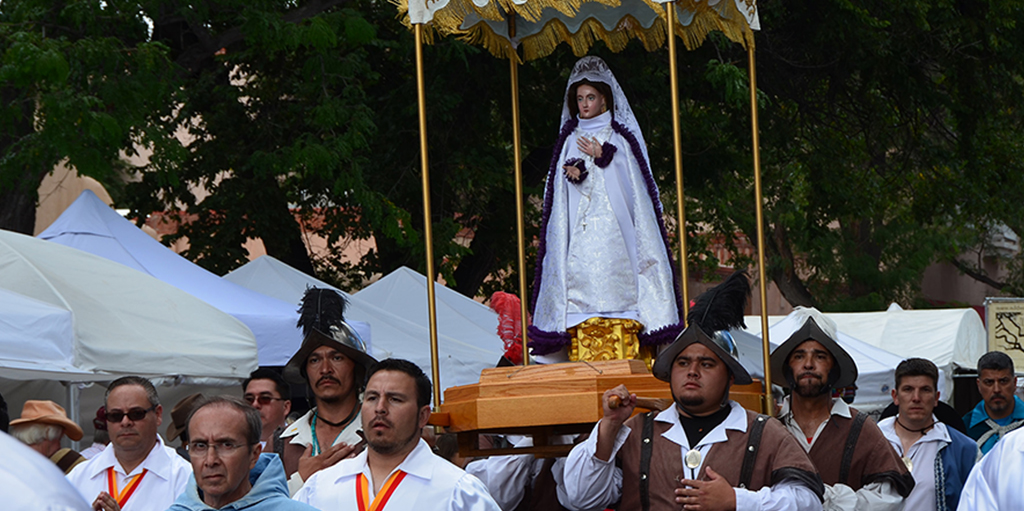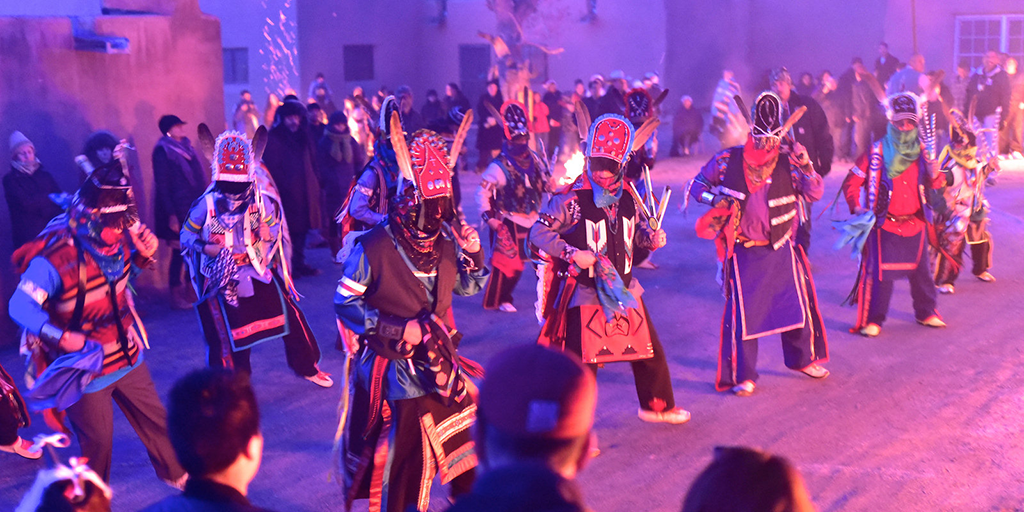The History of New Mexico
Collapse
Expand
-
Chapter 5: The Reconquest: Building a Durable Colonial Society
- The Reconquest: Building a Durable Colonial Society
- Waging Reconquest
- Renewing Spanish Colonial Society
- References & Further Reading

A los [glossary_exclude]Padrinos[/glossary_exclude] del Niño le pido en primer lugar si me da paso y entrada que al Niño vengo a buscar. Ya consiguimos le entrada congusto y con buen cariño pasaremos los Comanches a ver a ese hermoso Niño. Por los enfermos Niñito te pido en primer lugar con tus [glossary_exclude]mano[/glossary_exclude] poderosa Tú los tienes que sanar. Tú que eres tan bondadoso y me diste mi salud aqui me tienes presente bailando con ansiedad.
At twilight on a snowy Christmas Eve, los Comanches filtered into a New Mexico village while its residents sat in the chapel listening to mass. The Chief, El Capitán, led a group of about twenty other men, all clothed in buckskins, moccasins, and feather headdresses. They stalked quietly about town, taking mantas (cloaks), tools, and ropes from the buggies, wagons, and cars parked outside the church, and then moved on toward the houses around the town plaza. Among the group of Comanches was El Capitán’s daughter, La Cautiva. She was adorned in a communion gown that blended in with the white color of the intermittently falling snow.
El Capitán sought out one house in particular where his party would find El Santo Niño, or a doll of the Christ child dressed in swaddling clothes placed in a wooden manger. Nearing the house, El Capitán quietly sang:
| Spanish | English |
|---|---|
| A los [glossary_exclude]Padrinos[/glossary_exclude] del Niño le pido en primer lugar si me da paso y entrada que al Niño vengo a buscar. |
From the Godparents of the Christ Child I ask first for permission to come within for I seek the Christ Child. |
When they finally located the correct house, El Capitán continued the song:
| Spanish | English |
|---|---|
| Ya conseguimos la entrada congusto y con buen cariño pasaremos los Comanches a ver a ese hermoso Niño. |
Now that we are allowed within with pleasure and affection we Comanches will enter to see that handsome Child. |
Bursting into the living area of the house, the group overpowered El Santo Niño’s protectors, his padrinos, and carried the figure with them as they retreated to the plaza. Villagers poured out of the chapel in response to the padrinos’ cries for help, and a struggle commenced between townsfolk and Comanches. In the end, the raiding party made their escape with El Santo Niño. La Cautiva, captured during the skirmish by the villagers, did not flee with her kinsmen.

Courtesy of Larry Lamsa
Just outside of the village, los Comanches came to an abrupt stop. Instead of continuing their flight, they lined up ceremoniously and returned to the village plaza. Their procession was headed by El Capitán who held El Niño Santo in his hands. As the group passed by the homes of the elderly or sick who had not attended the mass that night, they sang:
| Spanish | English |
|---|---|
| Por los enfermos Niñito te pido en primer lugar con tu mano poderosa tú los tienes que sanar. Tú que eres bondadoso y me diste mi salud aquí me tienes presente bailando con ansiedad. |
In the name of the sick I beg of you Christ Child that with your powerful touch you will cure them. You who are so generous and gave to me my health you now see me before you dancing with yearning. |
At the same time, the men of the village had also formed their own ritual line, marching La Cautiva at the head of their procession. They similarly passed by the homes of the ill, calling on the healing power of the young child in their behalf. In the plaza, a band seated in an open wagon played violin and guitar music to accompany both groups’ ceremonies. When the chants concluded, the bells of the church began to ring, accompanied by the rhythm of tombés (hand drums) that called both groups back to the plaza.
With the line of village men facing the line of Comanches in the firelight directly in front of the chapel doors, negotiations for rescate initiated. El Capitán and the village mayordomo soon agreed on the terms for the exchange of their captives. The mayordomo provided los Comanches with locally produced wine, promised meals, and cash payments in return for El Santo Niño. For his daughter’s surrender, El Capitán pledged that his people would return once again on the community’s saint’s day, or to officiate when a community member was in need of a velorio (death vigil). In the flickering light of the farolitos (small bonfires) the men shook hands and returned their respective prisoners. Shedding their headdresses and buckskins, los Comanches reemerged as well-known vecinos (village residents), and La Cautiva, having changed into warmer clothing, also rejoined her family and the continued festivities. Although having its roots in the eighteenth century, this particular rendition of a ritual known in New Mexico communities as “Los Comanches” was performed in Placitas (a village located just to the north of Albuquerque) in 1938.
In the seminal study, Captives and Cousins, from which the above narration of the Los Comanches dance was borrowed and adapted, James F. Brooks details the means by which a unique borderlands society took shape in New Mexico during the late Spanish Colonial period. Isolated from New Spain’s larger communities, New Mexicans refined colonial customs to meet regional conditions. As Brooks has argued convincingly, New Mexico’s culture and traditions were forged through cycles of violence that were not “solely destructive but [that] produced enduring networks of economic and social relations.”1 In New Mexico, the cycles of violence were based on conflicts with Apache and Comanche peoples.
Don Diego de Vargas’ reconquest of New Mexico in the 1690s created new terms for the Spanish presence in New Mexico. Never again would encomienda plague Pueblo peoples. Indeed, in many ways the threat of raids by Apache, Ute, and, by the mid-to-late eighteenth century, Comanche bands pushed Pueblos and Spaniards to make mutual accommodations in order to hold off the nomadic peoples. One historian of the Vargas era has commented that the reconquest paved the way for a society that has perpetuated “an amazing continuity of people and place” in New Mexico.2 Such has certainly been the case since many present day New Mexicans (especially in the northern part of the state) trace their family histories back to the days of Vargas or even Oñate. What is often forgotten, however, was the means by which this durable culture was forged. This chapter will explore the complicated process of building a durable New Mexican society during the Spanish colonial period.